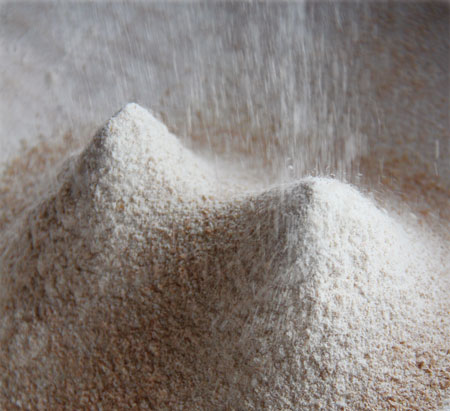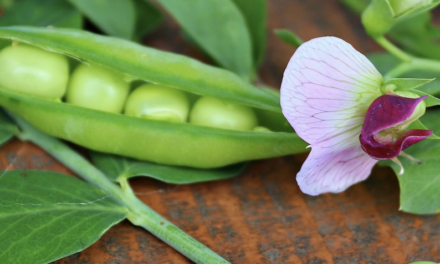By Paula Marcoux

When I was 14 years old, I persuaded my mother to buy a copy of the Tassajara Bread Book, by Edward Espe Brown of the Tassajara Zen Center. I promptly and repeatedly scoured this exciting and mysterious volume cover to cover, parsing it for critical clues to what I imagined was the super-groovy, culturally-evolved, and spiritually pure world of food—and contemporary life—in California. As a teenager in a small Massachusetts town in 1974, I was well aware that something was happening out there, and I was equally sure that I was born too late to be a part of it. So it was with a sense of being desperately behind the curve that I used the book, not just as a decoder ring for the counterculture, but as a novice’s manual for her first foray into good home bread baking.
Did my tolerant and good-humored, but by now slightly nervous, mother suspect that supplying her eldest daughter with the young sensei’s baking formulas and allowing her to rampage through her kitchen would provide a distraction from more common adolescent manias? She was surely aware that I suffered acutely from the feeling that I was missing out on everything; I was probably shooting out sparks of peevish resentment just for being born too late. If the book really was a feint on Mom’s part, it worked in spades: the Tassajara whole wheat intro to bread baking slowed me down, focused my attention, and was just plain fun. And it launched a lifelong obsession.
But what about the bread?
I shopped in Providence’s best “health food” store for the right ingredients, and followed all the directions, and, voila, we had whole wheat bread. It did everything it was supposed to in the recipes, and it certainly smelled great. We all enjoyed it warm from the oven, but it was admittedly a bit heavy and kind of…bitter? Acrid, even? Was that what was meant by “robust?” But, bottom line, it just wasn’t the experience I wanted it to be; and what did that say about us? Were we such backsliding, hyper-processed, white-bread people that we couldn’t deeply enjoy this honest, ancient food? What about my street cred as an aspiring hippie if I couldn’t even get the bread right? Or even appreciate the bread properly. (And it was soul-crushing torment that our household’s normal daily bread came from one of several excellent Portuguese and Italian bakeries in the Providence suburbs; sure it was white, but it was also crusty, chewy, fragrant and purely irresistible. My sisters and I could pretty much decimate one loaf before supper and another one during.)
It’s only taken about forty years for me to figure out that the flavor that tainted my teenaged whole wheat joy was rancid-tasting because it was, well…rancid. And I have become only surer of that recently because I have been baking with fresher and fresher flour and the difference is pretty stark. At best, the commercial organic whole wheat flour I have been using since this initiation period has been inoffensive, anonymous. But the combination of experimenting with flour sourced from farmer/miller operations, and tasting bread from bakers who mill in-house, has persuaded me to start grinding my own. I still buy organic white bread flour in bulk for some of my baking, but have been restored to a state of juvenile euphoria over whole wheat baking since I bought me a little mill and grind my own flour minutes before mixing my dough.
Now we have to worry about fresh flour?
Flour does not generally top the list of foods people feel it’s important to buy fresh. In fact, I’ve had it from all sorts of respectable sources, dating from the seventeenth century to last week, that the best flour for bread is aged flour. And in a limited sense, there’s some truth in that, as long as we’re talking about white flour, the ingredient valued for centuries by bakers and their wealthiest customers for the “best” bread. If the miller sifts away the bran and germ—the brown bits that begin to oxidize the instant the wheat kernel is violated by the mill—the remaining white parts are really pretty shelf-stable, and, get this, actually become whiter if the flour is left to stand around a while. Whole wheat flour, on the other hand, is very apt to spoil rapidly. So for all these years it has been a no-brainer to sift and age and charge a premium for the high-end white product: it has a long shelf-life, bakes easily into lofty, palatable loaves, and sold itself for centuries to a great many status-conscious customers who wouldn’t be caught dead eating bread below their station.
However, the human relationship with wheat is not a matter of centuries, but millennia. And right now, it’s not so difficult for the human, especially the baking human, to choose to reach back into the past, cut out a lot of middlemen, and produce a super-freshly ground whole-grain loaf that showcases the true flavor of the wheat. For those who are new to baking, it’s a great introduction to the art at its most elemental—grain, water, leavening culture, salt. For experienced bakers, it’s a liberation, a revelation, to get away from someone else’s idea of baking ingredients and to start from the ground up. So jump into this recipe anywhere you can. Not ready to mill your own flour yet? Buy some from a local mill and make sure it was recently ground. Not ready for sourdough baking? Use a pinch of instant yeast instead of the leavening culture in the recipe. Remembering my 14-year-old self, I fully recognize that you have got to just jump in from where you are. But, once activated, there’s no telling how far your baking gene will go to express itself: a little mill in the kitchen, a modest wood-fired oven in the backyard, a jar exploding with natural leavening on the counter. And then there’s the day you start measuring that useless expanse of turf in front of your house and calculating how many square feet you’d need for your personal wheat plot. Whichever level you are at, there’s always a little further to go to follow the bread genie.

The ancient way of leavening bread. The author adds a blob of a natural culture (sourdough), to a mixture of flour, water, and salt. The rest is just time and a few details.
How to get your leavening culture:
1. Gifting
There’s a good chance you know somebody who bakes sourdough bread, and take my word for it, they will be delighted to share their culture with you. If not, there is something seriously wrong with them or their culture and it’s a good sign that you should move on from both.
The dicey part, in terms of your relationship with the gifter: tactfully determine that the culture in question is composed of just flour and water. I’ve heard of unsavory mixtures involving milk and sugar and other items which, while they may be wholesome enough for humans to eat or to use in a bread dough, are far too exhilarating to truly nourish the dependable creatures you are soliciting to leaven your bread.
2. Capture
There’s nothing more satisfying than stalking your own personal culture at home. It’s especially easy and rewarding if you happen to be grinding your own organic flour, but you can use commercial organic whole wheat or rye flour as well. You also need a quart yogurt tub or suchlike sealable container and unchlorinated water.
Put a little (a couple tablespoons) of the flour in a bowl and add just enough water (drops!) to make a stiff dough. Knead in more flour with your fingertips until it is very stiff indeed. Fill your sealable container about ⅔ full of flour and bury the little dough lump within. Smooth the top of the flour and close the lid. Leave it on the counter and go about your business for a couple days.Look at the surface of the flour every once in a while without shaking it around. Within a few days you should see a crack forming in the flour, like dry soil around a sprouting seed—it lives! Dig the little miracle out of its floury bed and break it up in a bowl with a few tablespoons of warm unchlorinated water. Stir in more flour, knead it up, and repeat the whole deal—more-or-less doubling its size—each time the doughball tells you it is ready by cracking the floured surface. Soon you will have a culture that is copious and strong enough to start your bread. At that point you can dispense with the stiff -doughball-in-flour routine, and simply feed (or refresh, as the French so tastefully say) the culture by stirring in a good glug of unchlorinated water and enough flour to create a thick paste consistency. At that point, baking enough to use that increasingly active culture becomes the challenge for many of us, as the fiendish thing will thrive on its daily refreshments and demand to be baked with, no matter what our own human designs may have been. (Hint: planning ahead + your refrigerator = some semblance of control.)

You can start a new culture by kneading up a little lump of flour and water as a growing medium. Buried in a jar of flour, this humble little blob will develop its own ecosystem, capable of leavening generations upon generations of loaves of bread.
3. Networking in your local food community
Talk to folks you meet at farmers’ markets, bakeries, edible South Shore & South Coast events, local breweries, etc. Many, many people involved in our local food community are sourdough bakers or know someone who is. (I, for one, will try to remember to carry some of my pet leavening culture with me at all times after the publication of this recipe.)
Objective: Fresh Local Flour
What would it take to start up a local grain economy?
Admittedly, Southeastern New England has all kinds of decks stacked against it as far as becoming any kind of bread basket in the near future. But a brave cadre of local farmers and millers, inspired by similar visionaries in Maine and western Massachusetts, has begun pushing against daunting land and logistics issues.
Traditionally a pivot point in grain sourcing has been the miller, and in our region today, the Plimoth Grist Mill has provided that nexus. Like Gray’s Mill in Little Compton, R.I., they dedicate their water-powered stone-grinding to corn. But the millers at the Plimoth mill use an electric-powered Meadows mill to produce varietal bread flours—both whole wheat and a high-extraction white—from grain from Four Star Farms in Northfield and Lazy Acres Farm in North Hadley.
The most local source for flour may be your own kitchen.
When I decided that I had to start grinding my own flour, I took the path of least resistance: ordering a grain mill attachment for my Kitchenaid mixer. It cost less than $100 and arrived in a couple days, ready to go. I’ve been very happy with it, but there are plenty of other options out there for anyone who wants to read dozens of online reviews in light of your own particular circumstances.
Where to get the wheat?
More and more choices are appearing on the horizon. I used to have to buy big sacks of winter wheat berries, of unspecified variety, from Maine or out west, but now you can order directly from Four Star Farms or join the Pioneer Valley Heritage Grain CSA. Buying smaller bags of a few different wheat varieties allows you to have the fun of conducting your own baking trials: which variety makes bread closest to your ideal—Red Lammas or Warthog?
Even closer to home, the folks at Freedom Farm, right in Raynham, planted a small successful wheat crop last season, and offer both wheat berries and flour (variety: Expedition) at their farmstand. We learn that they have invested in a combine and are doubling down on the acreage in grain in 2018. Great news! We look forward to bringing our daily bread closer and closer to home.
Fresh-Milled Whole Wheat Bread recipe here.
Paula Marcoux is a Plymouth food historian and the author of Cooking with Fire (a book which includes copious baking notes and recipes as well as step-by-step instructions for building a clay woodfired oven). Her website is themagnificentleaven.com.






